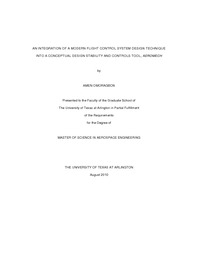
ATTENTION: The works hosted here are being migrated to a new repository that will consolidate resources, improve discoverability, and better show UTA's research impact on the global community. We will update authors as the migration progresses. Please see MavMatrix for more information.
Show simple item record
| dc.contributor.author | Omoragbon, Amen | en_US |
| dc.date.accessioned | 2010-11-01T21:29:07Z | |
| dc.date.available | 2010-11-01T21:29:07Z | |
| dc.date.issued | 2010-11-01 | |
| dc.date.submitted | January 2010 | en_US |
| dc.identifier.other | DISS-10806 | en_US |
| dc.identifier.uri | http://hdl.handle.net/10106/5174 | |
| dc.description.abstract | The aircraft conceptual design (CD) phase is the most abstract, thus challenging phase of the entire aircraft design process. It is the responsibility of the CD engineer to identify and then to explore various aircraft concepts with the goal of arriving at the most promising concept for further evaluation. During this early design phase, the discipline stability and control tends to be underrepresented due to the lack of non-linear aerodynamic and inertia data. The methodology and software AeroMech is a vehicle configuration independent aircraft conceptual design stability and control tool, developed to help the conceptual designer to address stability and control for conventional to unconventional design proposals. These include control power assessment for sizing control effectors, trimmed aerodynamics for performance estimation and evaluation of static and dynamic stability for safety verification. This tool has continually been refined over the years from its conception by Dr. Chudoba to its software implementation by Kiran Pippalapalli and Gary Coleman. The ultimate goal of this research undertaking is to increase the capability of AeroMech to assess an aircraft design for handling qualities in addition to safe flying qualities. This master research is the proposed first step to achieving a capability to shape an aircraft to possess good handling qualities. The objective is to augment the current flight control system design module to include a modern control technique of practical value during the conceptual design phase, which can be utilized to design for desired handling qualities in context with the airframe. This thesis identifies the research problem, the selection of a control technique, the implementation into a FORTRAN source code and the integration of this system into AeroMech. A thrust vectoring transport aircraft design example validates and demonstrates the new FCS module. The required methodology to design for good handling qualities is beyond the scope of this Master of Science. | en_US |
| dc.description.sponsorship | Chudoba, Bernd | en_US |
| dc.language.iso | en | en_US |
| dc.publisher | Aerospace Engineering | en_US |
| dc.title | An Integration Of A Modern Flight Control System Design Technique Into A Conceptual Design Stability And Controls Tool, AeroMech | en_US |
| dc.type | M.S. | en_US |
| dc.contributor.committeeChair | Chudoba, Bernd | en_US |
| dc.degree.department | Aerospace Engineering | en_US |
| dc.degree.discipline | Aerospace Engineering | en_US |
| dc.degree.grantor | University of Texas at Arlington | en_US |
| dc.degree.level | masters | en_US |
| dc.degree.name | M.S. | en_US |
Files in this item
- Name:
- Omoragbon_uta_2502M_10806.pdf
- Size:
- 7.255Mb
- Format:
- PDF
This item appears in the following Collection(s)
Show simple item record


